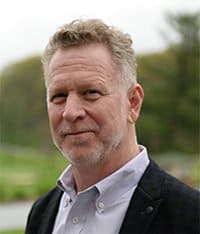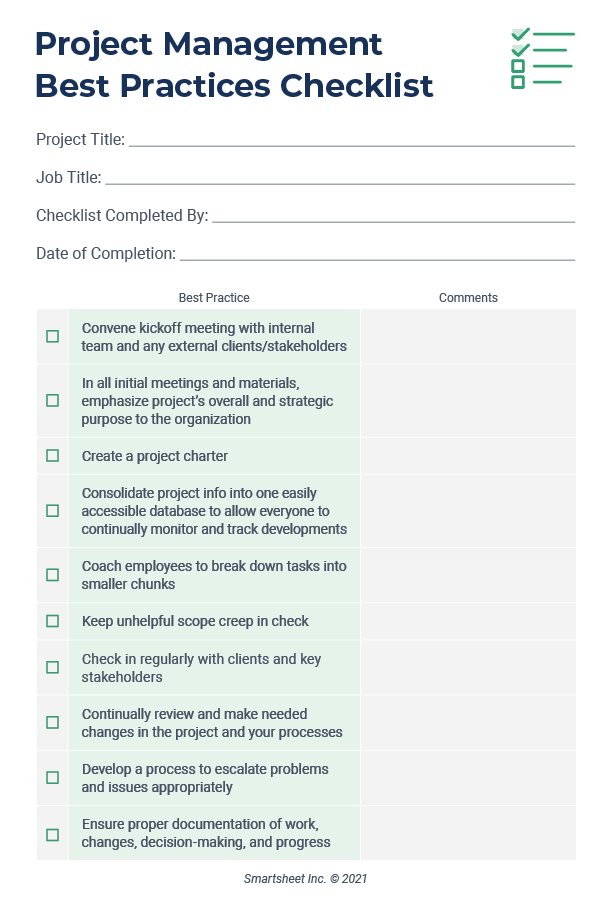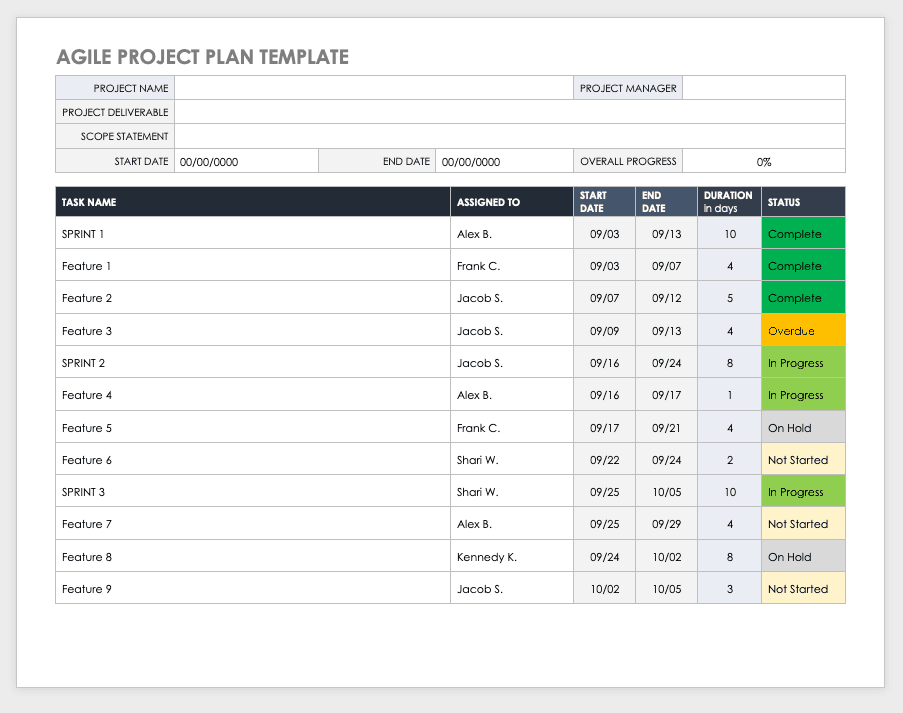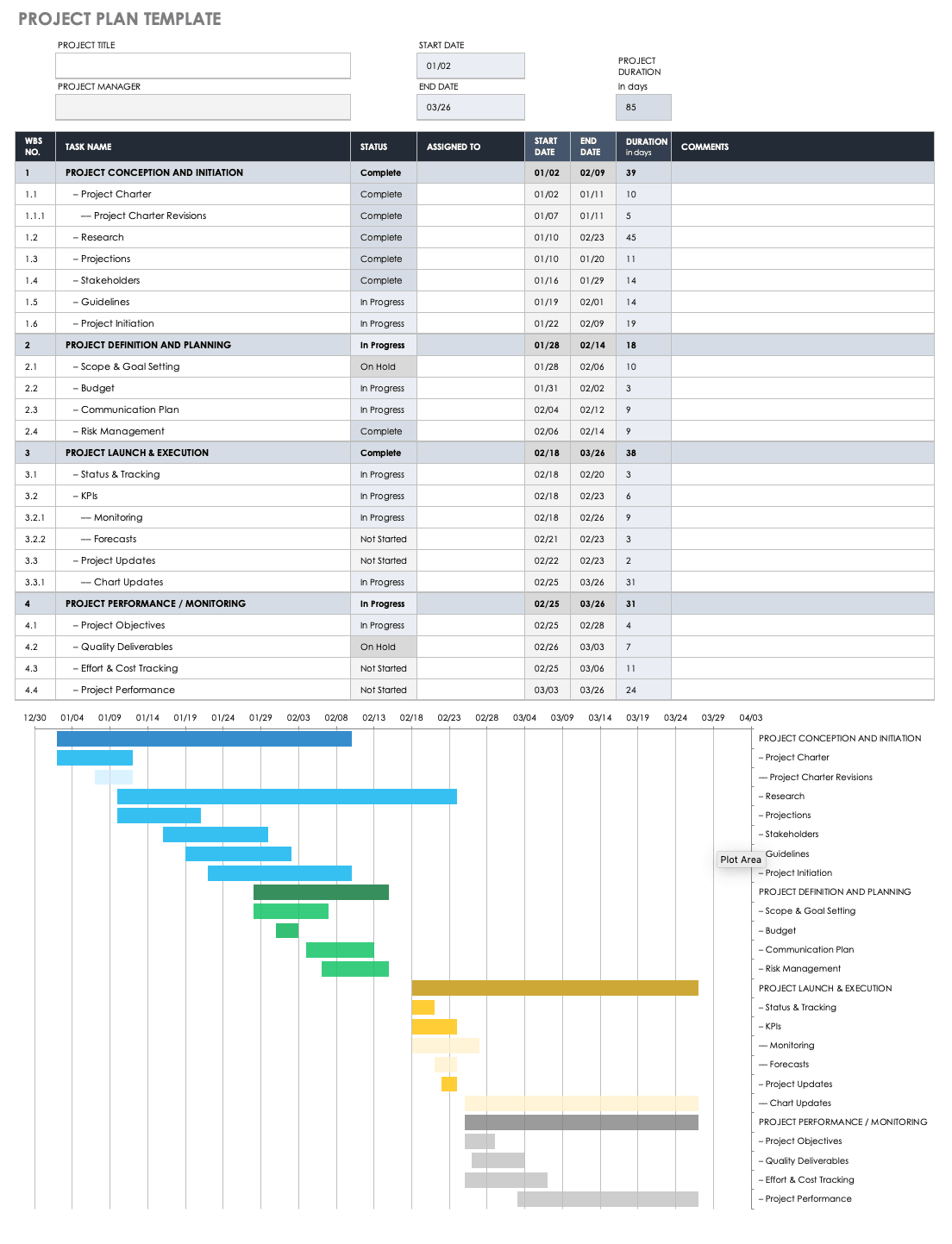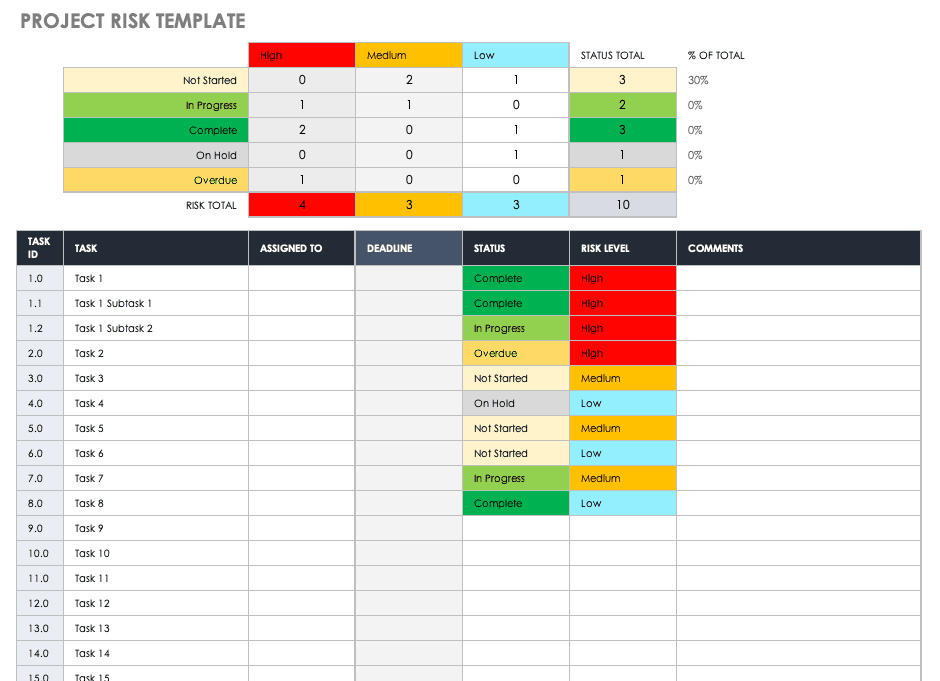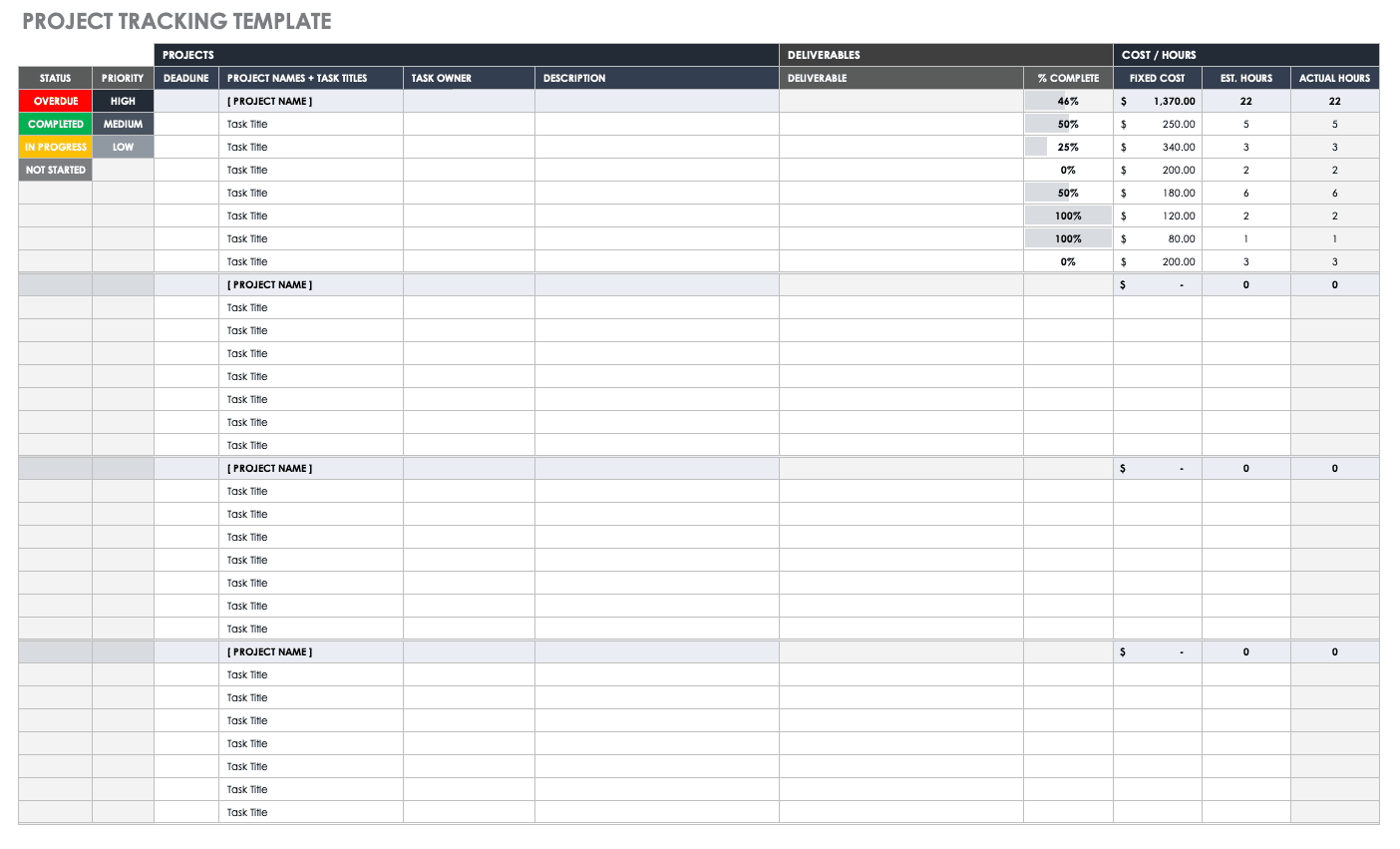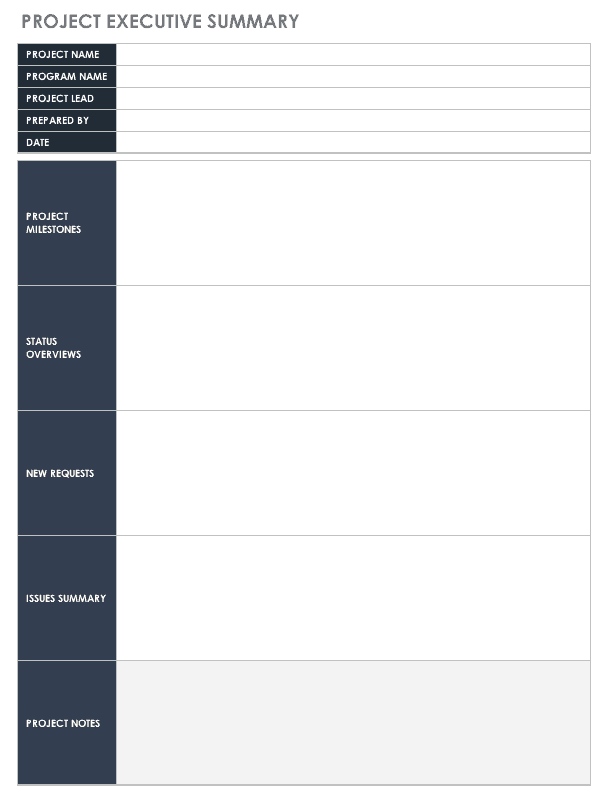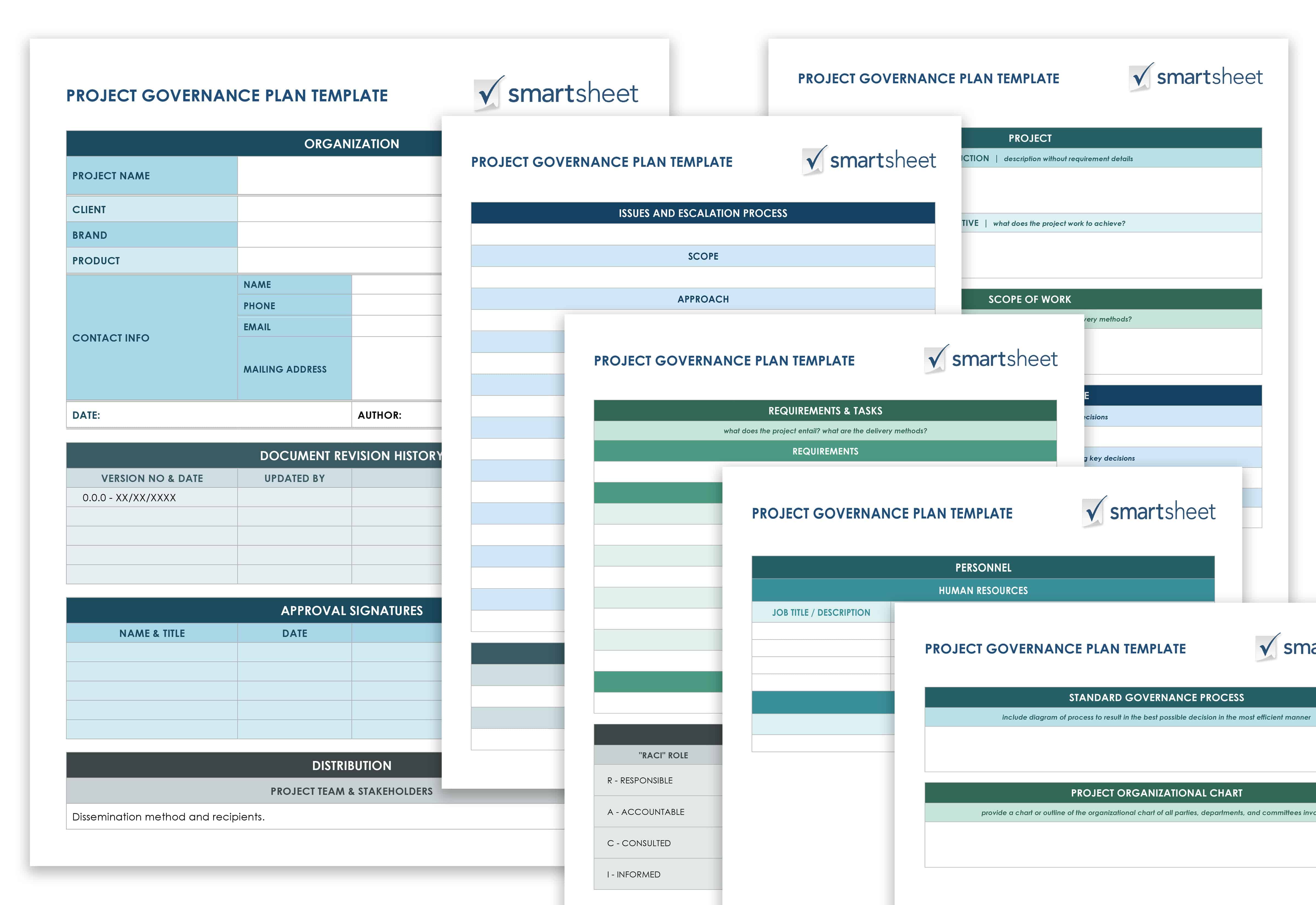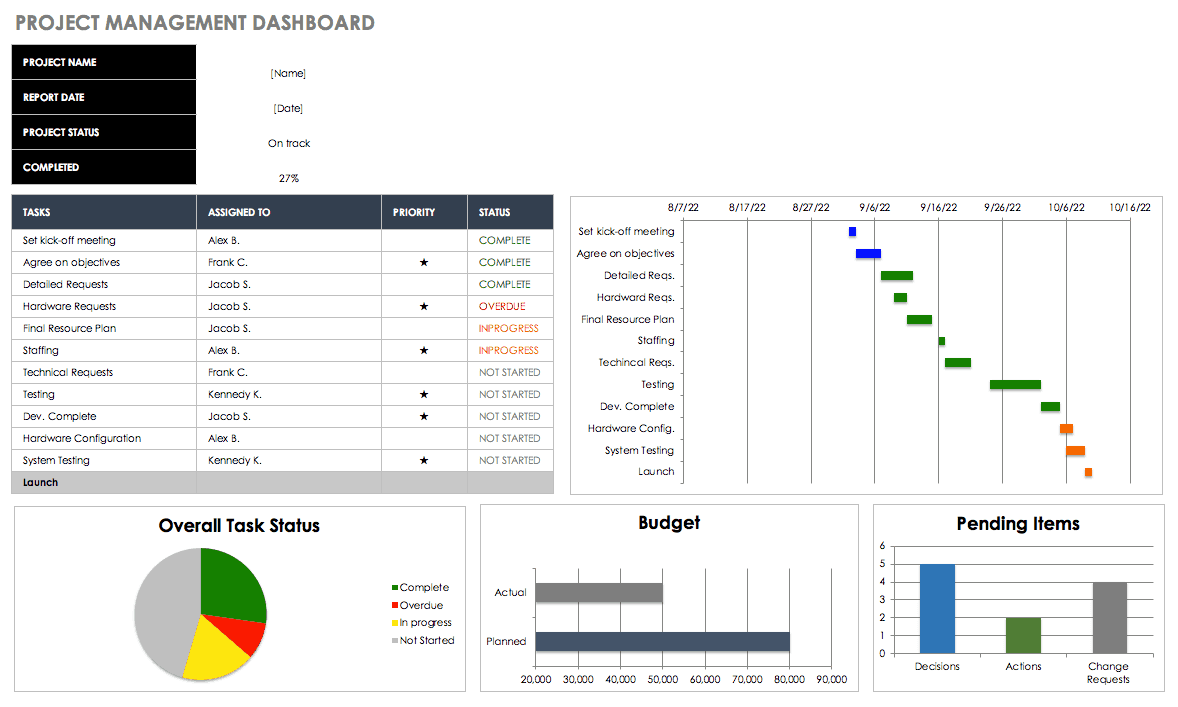What Are Best Practices in Project Management?
Many projects across a wide range of organizations fail. But project management experts recommend a number of best practices that can help keep projects moving and succeed.
Experts Recommend 15 Best Practices in Managing Projects
Below, we’ve compiled the 15 best practices in project management that experts say are vital to ensuring your project’s success:
- Hold a Kickoff Meeting — Or Two — with Internal Team and Clients
It’s important to hold a kickoff meeting in which you explain the overall goals of the project and how the project fits with the strategic goals of the organization. You should also provide an overview of the work and the timeline.
- Alan Zucker, a project management consultant and founding principal of Project Management Essentials, says you should do the following in the kickoff meeting:
- Establish ground rules for how the project will move forward.
- Establish clear expectations regarding roles and responsibilities.
- Set the project’s objectives and goals.
Some experts say you may want to hold two kickoff meetings. The first meeting should include any client(s) for whom you’re doing the work, important external stakeholders, and your staff. The second meeting can be for the internal staff assigned to the project.
Still, some experts emphasize the importance of that all-hands kickoff meeting with your staff, the external client, and important stakeholders. That allows your clients or stakeholders to become familiar with the project team and enables the team to gain a fuller perspective on a client’s needs and goals.
“Sometimes you may need to have separate meetings. But I would encourage teams to, as frequently as possible, have a team meeting with everyone from the team and the stakeholder executives present so that everyone hears the same thing,” says Saman Pourkermani, the Director of Digital Transformation and Product Development at Inspirant Group, a Chicago-area management consultancy.
“It's so much more impactful when I have a client representative talking to the whole team, including the people doing the day-to-day work. This way, they understand, ‘This is my problem.’ That means a lot more for the team. And it motivates them,” Pourkermani continues.
- Emphasize the Project's Overall and Strategic Purpose
Don’t just move your team into a project with a to-do list and deadline. It’s important that every team member understands how the project relates to the overall strategic goals of the organization.
“Emphasizing a project's overall strategic purpose — that's huge,” says Pourkermani. “I think that's very important. I would highlight it as one of my top 10. And make sure that not only the leadership and stakeholders are on the same page, but that everyone on the team knows what the project purpose is, too. There are going to be decisions that come up when team members are doing work from day to day. When they have that context very clearly embedded in their mind, it's going to help them to make the right decisions faster. We’ll get fewer situations where I need to pause and raise a flag and ask questions to clarify — ‘Is this really what you need for is this?’ That slows us down. Having that purpose will help them obviously create a much more meaningful product.”
- “It’s also important to be politically savvy enough to understand the organization’s true objectives and goals for any project and for its overall strategic direction,” says Sergei Brovkin, an international project management consultant and Founder and Principal of Montreal-based Collectiver, Inc. “There is a saying by an American politician a long time ago that there are always two goals: the good one and the real one,” says Brovkin. “With a project, there are two purposes: the good one and the real one.”
- Create a Project Charter
A project charter is a document that details some of the basic goals and requirements you covered in the kickoff meeting. The project charter outlines the project and includes key participants, the scope, objectives, and overall goals. People can always refer to the document and understand their responsibilities.
“[The project charter] is the project birth certificate,” says Brovkin. “You don’t know anything about your child yet — except that these are the parents and this is the name. Then, you have a goal: The project has to accomplish this, this, and this, and it has to be done by this date. This document makes your project legitimate.”
To learn more about the important elements of a project charter and download free project charter templates, visit “Project Charter Templates and Guidelines Every Business Needs.” - Consolidate, Track, and Report on Project Information Using One Easily Accessible Database
You’ll want to continually monitor and track progress in one online database that all team members can easily reach.
- “Collaboration tools are becoming more complex, because you end up having more complex, larger teams. And having that single version of truth is important,” says Elizabeth Harrin, Director of UK-based Otobos Consultants Ltd and an author, trainer, and speaker on project management.
Tools that provide this sort of tracking and reporting are continually changing. And some don’t focus as much on words and detailed reports as they do on visuals, says Zucker. (Learn more about new types of visual project reporting below.) - Coach Employees to Break Down Tasks into Smaller Chunks
Some tasks within a project can seem overwhelming at the beginning. And when team members face an overwhelming task with a distant deadline, they often don’t complete their work by that deadline. Good project managers help teach their team members to break down large tasks into small and achievable chunks of work. And they then set deadlines for each of those chunks.
You can learn more about breaking tasks into smaller chunks and other top project management practices recommended by the Project Management Institute by reading “A Complete Guide to the PMI PMBOK® Method.” - Keep Unhelpful Scope Creep in Check
External clients or executive leaders within your company will sometimes want to suggest new and different work that the team did not assume at the beginning of the project or in the project charter. Sometimes, that additional work doesn’t fit with the project goals or will have a major effect on deadlines within the project — or both.
At this point, project leaders must try to convince clients or executives that the new or expanded work isn’t appropriate for the project.
- “Sometimes I find that when you're working for a customer, people are afraid to push back when they see stuff that may exceed cost and schedule. So they have to get the courage to tell the boss that the baby's ugly,” says Cindy Young, a project management consultant and the President and CEO of CJ Young Consulting.
Many projects still appropriately follow the Waterfall method, where tasks are dependent on the completion of other tasks before them. Scope creep can be especially troublesome in those projects. “You can tell the sponsor everything that will go right or wrong with this project if they make that change,” Young says.To learn more about effective ways to combat scope creep, visit “Scope Creep: A Project’s Worst Enemy.” - Expect Change and Embrace It
While project leaders should fight scope creep in specific situations, they must also understand that changes are almost inevitable in projects — and those changes can result in a better product and a better result.
The Agile method of project management — at first most common in software development but now used in many other projects — embraces project changes. Even project managers who lead a modified Waterfall method of project management must be ready for changes in their initial plans.
“Sometimes that's the philosophy with traditional project management — to minimize the changes that come up because they can impact the timeline,” says Pourkermani. “Instead, acknowledge the fact that change is going to be a constant. We should expect it. Ask, ‘How do we get good at managing the change, adapting quickly based on the change, and actually taking it and using it to our advantage?’”
Harrin, from Otobos Consultants, asks: “What's wrong with changing what's in scope? If it's going to make the product more useful, we need to be far more nimble about achieving what our stakeholders want in an ever-changing environment.”
When issues arise involving possible changes, it can be helpful to bring your team together to brainstorm a solution. Having the right tools in place to facilitate collaboration and communication will expedite this process and the eventual resolution. Learn more about managing this type of project change at “PMI PMBOK® Guide Method.”
- Check In Regularly with Clients and Key Stakeholders
It’s vital to check in regularly with clients you’re working for, as well as with other key stakeholders. These check-ins will allow you to give an update and get their opinions.
“Seek regular feedback from customers and key stakeholders,” says Zucker. “Show them what you are developing. This reduces gaps in expectations of delivery.”
Pourkermani also suggests holding periodic meetings with the full team, including clients and important stakeholders. If the full team includes hundreds of people, those meetings may happen only about once every three months. If the team includes a dozen or so people, hold the meetings every two weeks or month.
“The purpose of [these meetings] is just to stay aligned and synchronized as a project team, with your stakeholders and customers,” he says. - Continually Review and Make Needed Changes to the Project and Your Processes
You must do more than embrace change in elements of your project as you’re doing the work — you must also be willing to make changes in your processes.
“We should focus on having frequent retrospectives throughout the project,” says Pourkermani. “It’s not just about the product or the thing we’re building or delivering, but also about how we’re working in the process we’re using. For example, is the planning process we’re doing the most effective way? Re-evaluate frequently throughout your project and have a mechanism in place to continuously improve the way you're actually doing the work.”
“Agile has these retrospectives,” says Harrin, “so we’re iterating on performance and process at the end of every iteration.”
Zucker is an advocate for Kaizen, a Japan-born practice that focuses on continual process improvement. The Japanese word translates into “change for the better,” and organizations use the practice in project management, manufacturing, and other areas.
“Kaizen is a concept that came out of Toyota and the company’s Lean production system,” Zucker says. “It was the idea that teams of workers that were building cars could identify ways of improving the process, and those changes were actually implemented. That whole idea of continuous improvement — in scaled Agile they call it relentless improvement — is the idea that at the end of our sprints, we have our sprint retrospective, where we identify ways of improving. And we actually implement those improvements, or some of those improvements, in our next iteration or our next sprint.”
To learn more about Lean and Kaizen, visit “The Definitive Guide to Lean Project Management.” - Make Your Relationship with Your Client a Priority
Young says that means more than obligatory check-ins. That means you read and answer their emails, as well as return their phone calls, quickly.
“Your customer feels important and more than just dollars,” she says. “When your customer realizes that you are prioritizing them, they will respond to the questions needed to support them and won't feel that you are just working for them, but that you are part of their team as well.” - Develop a Process to Escalate Problems and Issues Appropriately
Issues and problems often fester at the lower levels of a project team. Lower-level workers don’t want to tell senior project leaders, clients, and key stakeholders of the issues for fear of rebuke or censure.
At the beginning of your project, create an issue escalation matrix that identifies the level of importance of an issue and the appropriate escalation path for different types of issues.
Zucker also says that escalation can happen less formally — if you have daily stand-up meetings and follow-up meetings that are part of Agile and other project management methods.
“Create processes so that problems and issues are solved quickly,” he says. “Identify issues in the daily stand-up meeting and resolve them immediately in the meeting after.” - Ensure Proper Documentation of Work, Changes, Decision Making, and Progress
Maintain detailed documents about the basics of what’s happening with the project. This means documenting project objectives and tasks, bottlenecks, scope changes, and task dependencies. This documentation can help new team members become familiar with the project. It can also help you make better decisions and learn from issues and problems.
The software that your team uses to help monitor and track the project should aid your documentation. For more assistance, you can also download free project management templates to use by visiting “Top Project Management Excel Templates.” - Be Ready to Kill a Project if Necessary
Sometimes it’s necessary to acknowledge that the goals of your project no longer fit with business realities. Those business realities — potential demand for a product or a product’s usefulness in the marketplace — can change quickly.
- “We’re now running into a different kind of scope creep,” says Raman Attri, an author and speaker on project management and business proficiency. “Because what happens is that when we run the projects, the danger is not about going out of scope. The danger is that technologies change in the meantime so that the solution we had originally in mind may not even be workable.”
When that happens, you need project leaders strong enough to recommend ending the entire project. You have to ensure that you don’t waste more organizational resources on a suddenly bad idea.
In those cases, your organization must make a very basic decision, Attri says. “Should we continue doing this project or should we kill it? There are instances where management has been very harsh in killing the project — because they know it's not valid anymore,” he says. - Understand the Importance of Context
Every organization and every project is different. Even a similar project within the same organization is different when it occurs at a different time.
The bottom line is that the environment and context a project exists in are very important. Keep this in mind as you consider which best practices are essential to follow for your project and which you can leave behind.
“One of the things that I spend a lot of time talking about when I'm teaching is the idea that context counts,” says Zucker, from Project Management Essentials. “Every project, every organization, and every industry is somewhat different. Recognize that projects and project management are not a one-size-fits-all endeavor. When you're making decisions as project managers, you need to understand the environment that you're operating in, and then make decisions accordingly. That is very valuable.” - Best Practices Isn’t Only a List — It’s an Ongoing Process with Tweaks
Harrin, from Otobos Consultants, says you’re not doing good project management if you only follow a best practices list. You must make adjustments that make sense — even if they aren’t on a list or even seem different from traditional best practices.
“The term ‘best practices’ implies there's one set of things that we have to do and tick every box,” she says. “And because of how project management is now moving away from Waterfall … into a way that's far more inclusive — that covers Agile and hybrid methodologies — then there is no one single set of best practices. So what you're coming up with is a list of good stuff that people should do. But I'm not sure that I would be comfortable describing everything I do as a ‘best practice.’ That implies that anything that deviates from that is incorrect, in some way. Or that it might not give you an optimum outcome.”
Project Management Guide
Your one-stop shop for everything project management

Ready to get more out of your project management efforts? Visit our comprehensive project management guide for tips, best practices, and free resources to manage your work more effectively.
2021 Project Management Best Practices Starter Kit
This starter kit, which includes a best practices checklist, an implementation cheat sheet, and a template package, will help you and your team to understand and implement the basics of best practices in project management:
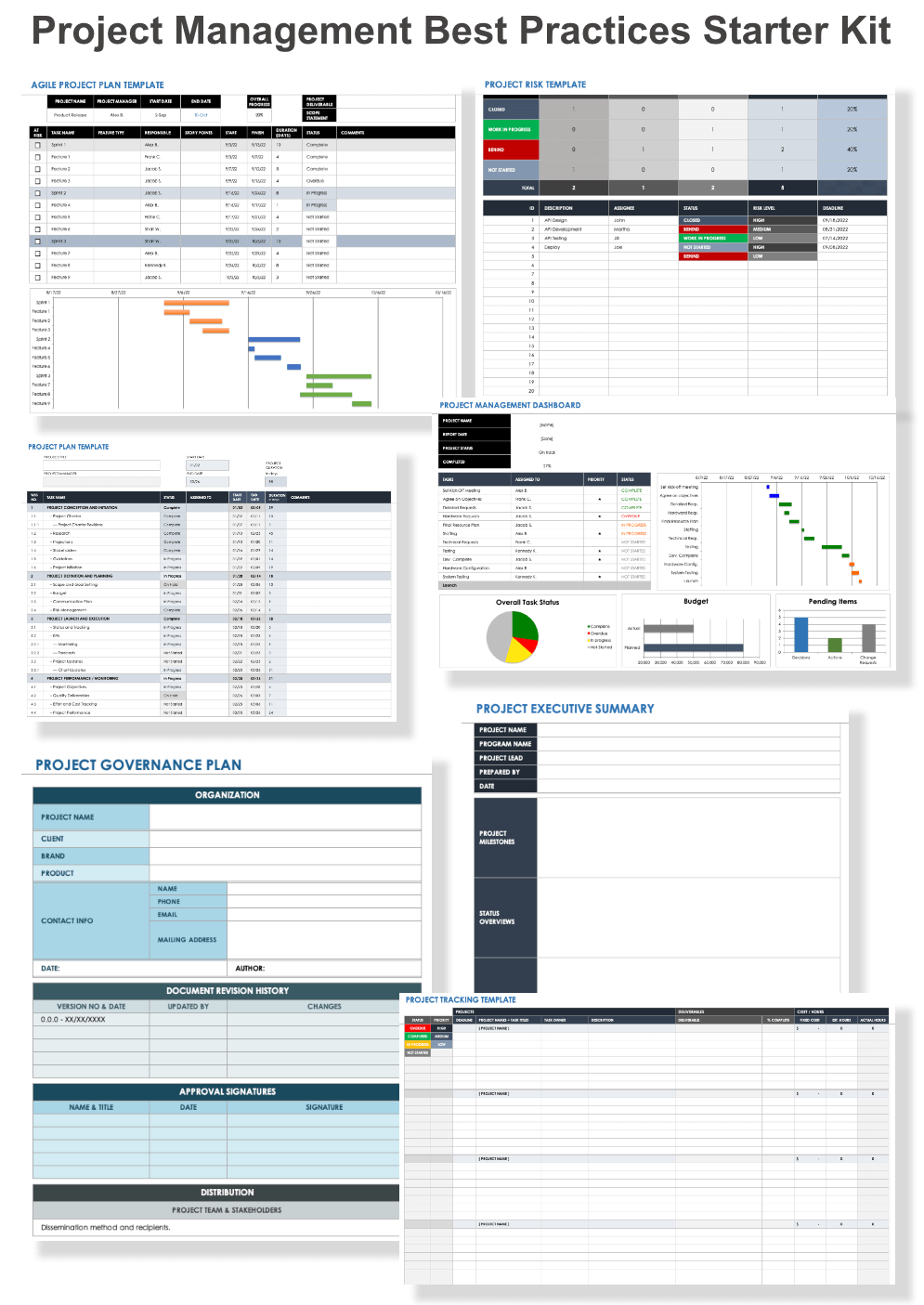
Download 2021 Project Management Best Practices Starter Kit
Project Management Best Practices Checklist
Your project leader and team can use this project management best practices checklist to ensure they are following some of the most important best practices in managing projects. The checklist includes tips on facilitating a kickoff meeting, creating a project charter, regularly checking in with clients, and developing a process to ensure that you deal with any project issues quickly.
Download Project Management Best Practices Checklist - PDF
Step-by-Step Cheat Sheet on How to Implement Best Practices
Your team can use this simple cheat sheet to understand how to help an organization implement best practices in project management, step by step. The cheat sheet provides tips on encouraging organizations to talk about problem areas, quantify the costs of those problem areas, and information on how to shift project management language from processes to accomplishing overall goals.
Agile Project Plan Template
Use this Agile project plan template to help plan your project using the Agile methodology. This template includes entries for specific Agile sprints, along with features within those sprints. It also includes sections for team members who are responsible for each item, planned start and finish dates, and current status.
Download Agile Project Plan Template
Project Plan Template
Use this project plan template to create a detailed plan for a project. This template allows you to create detailed entries in all project phases. It includes entires for project conception and inititation, definition and planning, launch and execution and performance and monitoring.
Download Project Plan Template
Project Risk Template
Use this project risk template to help you assess and provide details on risks that might affect your project. This template helps you assess the risks associated with various tasks in your project and whether those risks low-level, medium-level or high-level risks.
Download Project Risk Template
Project Tracking Template
Use this project tracking template to monitor progress on more than one project. This template includes entries for tasks for various projects, and includes entries to show each task’s priority and the status of the task — whether the team has started working on it, is still working on it or has completed it.
Download Project Tracking Template
Project Executive Summary
Use this project executive summary template to help provide an overview of a project for company leaders and employees who may be less involved in the project. This template includes entries for project lead, project milestones, status overviews and any issues with the project.
Download Project Executive Summary
Project Governance Plan Template
Use this project governance plan template to provide details on a project and how it will move forward and how project leaders will manage and coordinate it. This template include entries for scope of work, requirements, specific tasks, who is responsible for which deliverables. It also includes entries for tracking any issues and how the team will alert company leaders and get them resolved.
Download Project Governance Plan Template — Microsoft Excel
Project Management Dashboard Template
Use this project management dashboard template to provide an overview on a project and its status. This template includes entries for tasks, who is responsible for the tasks and progress on all tasks. The template also provides graphical overviews on the status of tasks and the planned budget vs. actual spending.
Download Project Management Dashboard Template — Microsoft Excel
Get our entire project management template starter kit, which includes all of the above templates in one easy-to-download file.
Download Project Management Template Starter Kit
Best Practices in Building and Maintaining Great Project Teams
One broad area of best practices in project management might be the most important: building good teams. Without good teams, projects are very likely to fail.
Here are top tips from experts on building and maintaining great teams:
- Don’t Focus Only on Project Management Professional and Other Certifications in Choosing Project Managers
Certifications can be important, including the well-regarded Project Management Professional certification from the Project Management Institute. But not every project needs a leader with a PMP or similar certificate. And many project managers without certificates are great project managers, says Young.
Young learned a lot about project management through her 23 years in the U.S. Navy, she says.
“There are people who are really great at project management and have done it for years. I see them do it day in a day out in the military. When you're in the military, you don't have to be PMP-certified to manage a project. And there, they've gotten a lot of experience. So you don't necessarily need a PMP to have a project go well. Don't overlook people who might be good at it and have good experience with it, even if they don't have a PMP.”
To learn more about project manager certifications and training courses, visit “How to Become a Project Manager.” To learn more about what makes a strong marketing project manager, read our article on macro and micro marketing PM skills. - Don’t Assume Project Managers Must Be Subject Matter Experts
Organizations will sometimes say they need a project manager with a specific number of years of experience as an engineer, for example. Or that they need a project manager with deep management experience in a specific industry. Brovkin, from Collectiver, Inc., says those are most often misguided requirements.
“The thing is, if you want me to work as an engineer, then you have the wrong person,” he says. “Because I am an engineer, as a matter of fact, with a broad background. I can figure out what needs to be done in many areas of engineering. But I'm not supposed to be doing that.”
In fact, being an engineer — or having some other expertise — can be detrimental to being a good project manager, he says. You might have a tendency to poke around in details that don’t concern you.
“The best practice is to find the project manager who can clarify the tasks, put together a very good team — one that is cohesive and well-aligned with the true purpose of the project. Then get out of the way,” Brovkin says. - Be Especially Thoughtful About How You Put Together Teams
One of the most important determinants of your project’s success is the makeup of your project team. Team members must be aligned. They should have similar values, the same attitudes about project goals, and a shared understanding of how to do the work.
“If a team is well-aligned, and I know that as project manager, it is much more effective, efficient, you name it,” Brovkin says. “It's a pleasure working there. Your projects are on time. Everybody’s happy. Everything is going to be fine.”
Brovkin says that teams that are put together with some care become very effective and efficient, and they can operate almost like a human brain.
“If I throw a ball at you, what do you do? Without even thinking, you move your arm, you open your hand, you catch the ball, and you close your fingers. Are you telling your fingers or your arm what to do? No. You do not really even think through it. And if I asked you, ‘How did you do it?’ it would take you much longer to explain than what probably happened. That’s how the team should work.
“The CEO does not have to look at it and say, ‘I see a ball flying in my direction.’ You guys tell your guys to start moving their arms, right? And so on and so forth, until they get to the last guy on the front lines who moves the fingers. It doesn't happen like that. This is because the team has to work as an organism,” says Brovkin. - Fund the Team, Not the Project
Once you have put together a good team, you don’t want to dismantle and change it for every project that comes along, Zucker says.
He cites Tuckman’s model of group development, a model that psychologist Bruce Tuckman wrote about in the 1960s. The model cites four stages that groups move through: forming, storming, norming, and performing. Each stage represents a step in the team getting together and then learning to work well together.
Zucker says that once the team gels and begins to work well together, you shouldn’t disband it just because the project ends. Instead, the team can work together on ensuing projects.
He says: “Fund the team — not the project. Build high-performing teams. Keep the team intact and funnel the work to the teams.
“The idea is we begin to build long-standing, persistent teams, where we've got a team that's together, and then the team develops their performance and knows how to work together. If we keep forming new teams, we’re always going back to the beginning,” Zucker says. - Consider Team Members’ Strengths in How You Assign Work
Even with a well-formed team, you will have team members with different talents and strengths. Think carefully about those as you assign the work. Play to each team member’s strengths, and leverage those strengths whenever possible.
- Have Regular and Frequent Check-ins with the Team and Each Member
Regular check-ins — with the team as a whole and with individual team members — are vital.
Short daily standup meetings with all team members are an important part of the Agile project management method. But many other project management methods can do something similar. The meetings should be short — often no more than 15 minutes. Everyone can talk about what they did the previous day, what they are planning to do today, and what hurdles — if any — are in their way.
It’s also important to hold individual meetings between a project manager and each team member. The team member and project manager can talk more specifically about the team member’s work, any issues they are having, and goals. These individual meetings usually won’t be held daily, but rather weekly, or even bi-weekly if you’re working with a big team. These meetings are important no matter the size or length of the project.
A recent study of more than 1,100 remote workers found that the frequency of check-ins mattered less than their consistency. Whether they are weekly or at some other frequency, hold the check-ins on schedule.
The same study also found that 46 percent of the remote workers said the most successful project managers had regular check-ins with them. - Mind Each Team Member’s Workload
As you set up and continually adjust your project’s work plan, make sure you understand each team member’s workload. If a project manager doesn’t track it, important tasks and deadlines within a certain area of the project can overload individual team members, which will make these team members less effective and more frustrated. This will hurt the project’s overall progress.Harrin, from Otobos Consultants, has a related recommendation: Project managers should always think about team members’ overall mental health as it relates to their work.
“While we are not mental health practitioners as project managers, there has been a discussion around well-being at work and making sure that we are alert to the needs of our team,” she says. “I think that there's an acknowledgement that life on a project is stressful, and that's something that we could be better at.” - Engender Trust Within the Team
When you have a team with similar values and attitudes, you have the important ability to build trust with each other.
“The foundation of (a) team’s functionality is trust within the team,” Brovkin says. “If you have trust, you don’t have to say, ‘Has your boss signed this?’ You know, the usual thing in a corporation — all the contracts have to be signed by the top boss. Because there’s no trust. For the team to be effective, everything has to be built on trust.” - Be Politically Savvy as a Project Manager
It helps to have political and people skills as a project manager. At times, you may want to cajole organization leaders for resources that can help the project, and you’ll need to understand how to do so. At other times, you might need to replace a team member with someone who better fits the project and team, Brovkin says.
“You may have to go to the line manager and say, ‘Could you replace this guy?’” Brovkin notes. “Will it happen? Maybe yes, maybe no. If you are a good schmoozer and that department has enough bandwidth, they can replace that person with someone else. It has nothing to do with project management but more to do with corporate politics. I don't want to call it a best practice, but it is a best practice to have a project manager who's politically savvy.” - Create an Environment Without Fear
Team members have to feel free to propose ideas, as well as to raise concerns about things that aren’t working, without team leaders ignoring, belittling, or admonishing them. They must know they can make mistakes if they come from good intentions.
“Embrace diversity and create an environment without fear,” Zucker says. “Everyone and all ideas are welcome. No one goes to work planning to screw up. Use mistakes as teachable moments.” - Celebrate Your Successes
Take the time to celebrate successes with your team, Harrin says.
“We don’t do that enough,” she says. “It's not necessarily more important than any of these other things. But even if a project is closed prematurely, we need to celebrate the success of what we did manage to achieve — because life is hard, and it's nice to reflect on what we've managed to pull off.”
Past Best Practices That Are Becoming Obsolete
Experts say some past best practices are becoming obsolete. These tendencies may never have been as helpful as people thought, or perhaps they don’t work as project work is changing and needs to be more nimble.
Here are some outdated best practices that experts say are no longer relevant:
- Convene with Routine In-Person Meetings
Many in-person meetings, with team members and with clients, are unnecessary and wasteful, Young says, especially when team members are working in different offices or — increasingly these days — remotely.
“You’re saving the customer and yourself time that you have to travel,” Young says. “You don't have to book a conference room or anything. I mean, yeah, we get Zoom fatigue. But that’s pocket change. I prefer it because I can get back to work immediately afterward.” - Create Detailed Scope, Objectives, and Timeline Documents
In traditional project management practice, the project manager would create a detailed plan upfront, including particulars on requirements, specific tasks, and deadlines. Typically, those plans would take weeks or more to create.
But those plans seldom work — whether in creating software or other products or in any other type of project.
“The challenge with that approach is, by the time we get to development (of a product) or even testing, it could have been several months,” Pourkermani says. “The market may have changed. That's one thing: It takes much longer to get things out.”
Pourkermani says having a basic roadmap of the project is important and “very, very valuable. But avoid the trap of spending several weeks to months coming up with a detailed project plan upfront. We all know that the day you're done with that plan, it is obsolete.
“Instead of spending so much time thinking about some of the minute details, have a higher-level plan that tells you, ‘Hey, in the next few weeks, this is where we're going to go.’ That is much more valuable. We put more emphasis on getting enough planning done so that you can actually start the work sooner and get to execution sooner.”
Harrin says a better process is to do the “rolling wave planning, progressive elaboration” that project managers now use in many project methods. The idea is inspired by the Agile method.
“It is a much more user-friendly, time-friendly, and stakeholder-friendly way of building up plans for long, long projects,” she says. “Yes, have a clear plan. You obviously want a schedule of the overall big picture. But you might not get all the details.” - Develop and Formalize Project Management Roles
You’ll likely establish top roles and a few other important roles on your project management team. But don’t formally establish roles for all or even most team members.
“Agile teams, including Scrum teams, tend to be self-organizing,” Harrin says. “Often people within those teams would be multidisciplinary, so they are able to take on multiple roles. That's not to say they wouldn't have defined roles. But they might have three roles in one person. I think there's a trend toward people in a more hybrid job.” - Manage Risk Upfront, Including by Creating a Risk Response Team
You will certainly want to assess the risks to the project upfront and figure out how to lower those risks. You’ll also want to have some sense of how your team will respond when problems come up. But you shouldn’t overly plan risk management at the beginning, and the separate risk-response teams that experts have suggested in past years are generally a bad idea. Those are smaller teams within a project team that are responsible for assessing and responding to risks or hurdles causing problems with the project.
“The people who will be best at managing and addressing risks are the team members themselves,” says Pourkermani. “Have the team own the risk. Don't create a response team.”
“These days, we do not have risk-response teams,” says Attri, the author and project management speaker, “because everything we do in project management is a risk. There's a risk of schedule, risk of quality, risk of stakeholder expectation, risk of timelines, of everything. Fundamentally, what we're saying is every point of project management, we are managing risk. This is the core responsibility of the project leader.”
- Create a Detailed Work Authorization and Change Control Process
Changes in your project will happen, and you should adapt quickly. Create a process to quickly acknowledge and approve changes, but not one that is so complicated or formal that the changes don’t happen quickly. - Sign a New Agreement with Clients and Important Team Members after Scope or Other Changes
In the past, some traditional project management methods required written approval from clients and important project leaders on any changes to the scope or schedule. However, that process was unwieldy and often delayed important work.
“In the olden days, when I first started managing projects, I had a project document,” Harrin says. “I would walk around the office, I would stand at people's desks and make them sign it. That doesn’t happen anymore.” The chance of getting the document signed was remote, she says.
She says you still will need written approvals — especially from clients — on important changes. But that can often be a simple email approval or an e-signature. Rewriting and circulating a formal document is unnecessary and inefficient. - Convene a Final Wrap-Up Meeting or Post-Mortem
Rather than holding a wrap-up or formal post-mortem meeting, you should talk about and deal with any issues that project team members bring up throughout the project.
“Instead of having a post-mortem at the end of a project, focus on having frequent retrospectives throughout the project,” says Pourkermani. “Not just about the product or the thing that we're building or delivering in the project, but also about how we're working, about the process we’re using. Is this process of planning that we're doing the most effective way? Re-evaluate that frequently throughout your project and have a mechanism where you're continuously improving the way you do the work.”
“Wrap-up meetings and project post-mortems, I think, are probably decreasing,” Harrin says. “I think people are holding them — should be holding them — on an iterative basis. I think there is stuff to do relating to post-mortems and the thought process that goes with that. But I don't think you should wait until the end. Sensible project managers are looking out for lessons learned throughout the entire project.”
FORMER BEST PRACTICES THAT ARE BECOMING OBSOLETE
Here are several past best practices that experts say are less important — or are obsolete — as projects and project management have changed.
| PAST BEST PRACTICE | WHY IT'S OBSOLETE OR LESS IMPORTANT |
|---|---|
| Convene with Routine In-Person Meetings | Many in-person meetings, with team members and with clients, are unnecessary and wasteful. This is especially true when team members are working in different offices or — increasingly these days — remotely. |
| Create Detailed Scope, Objectives, and Timeline Documents | Detailed scope, objectives, and timeline documents often take too long to develop and quickly become irrelevant as the project changes. |
| Develop and Formalize Project Management Roles | You will likely establish some top roles, but much of your team will self-organize, and some team members may hold multiple roles. |
| Have a Separate Risk-Response Team | Assess risks to the project upfront and manage those risks. But the risk response teams sometimes recommended in the past aren't effective. Your project team members should themselves be always involved in risk management. |
| Have Detailed Work Authorization and Change Control Process | Detailed authorization and change control processes are inefficient and ineffective. Get written approvals for important changes but that you can accomplish through emails and digital signatures. |
| Convene a Final Wrap-Up Meeting/Post-Mortem | Discuss important issues, which you might formerly have covered at a final meeting, at check-ins throughout the project. Deal with the issue, and move on. |
Future Trends in Good Project Management
Experts cite some new practices that are trending in good project management. These tips can help move projects forward more effectively and efficiently.
- Action-Oriented Project Management
Attri suggests that project management of the future will move away from the linear nature of many projects. It’s too time-consuming and doesn’t produce good enough results in a reasonable time period, he says.
“In traditional project management, you start from left to right. You start with scope, then align with our stakeholders, (then) we start looking at what our plan is and start looking for resources.” For a traditional project, you then set a date at which the project will finish, Attri says.
But Attri says that approach often works far too slowly, as projects take too long to finish.
Instead, he says, project leaders should say: “‘Let's start from the outcome — what does the outcome look like? What does it actually contain? What do the specifications look like?’ And now, let's work backward. ‘What kind of resources are we really going to need? Are we going to need three people? Are we going to need six people? And each of those people, are we going to need them for one month, two months?’ And if I put the timeline on that, then I can complete it in three months — as opposed to one year. I might need these resources. I might need to eliminate this entire function. I might need to kind of kill this side project. So now, working backward gives you that speed.”
Attri says that organization leaders will immediately value an approach that finishes projects more quickly. “Once they taste it, they’re never going to let you go back to the one-year kind of project management,” he says. “They’re always going to expect this highly accelerated project management and think that is going to be the norm.” - Tracking and Reporting Through Simpler Visuals and Graphics
Zucker says many project management teams are moving away from traditional written status reports, “which were usually poorly written and rarely read.” Now, more teams are showing progress on a project more visually. Examples include Kanban boards, whether in the office or through online portals.
“The things I like about Kanban boards is that they’re clear and they’re visual,” Zucker says.
To learn more about the Kanban framework and Kanban boards, visit our comprehensive guide to the Kanban method.
Real Examples of Project Management Best Practices in Action
The use of some basic best practices in project management can have a real effect on actual projects. Here are real-world examples:
- More Efficient Meetings
A high-tech company Brovkin consulted for realized it was taking too long to produce updated versions of its software. Part of the company’s normal process was to get 22 directors together for meetings three hours each week.
Brovkin coordinated work so that fewer people could meet for much less time and still get the work done.
“I said, ‘Listen, guys, you're talking about efficiency. If 22 directors spend three hours together, do you know how much that costs?’” he says. “So I booked a room that could accommodate only 10 people, and I booked the meeting from 11 to noon. At noon, everybody wants to have lunch, right? Nobody suffered. The meeting went much better. The actual cost of the project instantly was cut down.” - Monitoring Team Capacity to Ensure It’s Not Overloaded
Pourkermani, with Inspirant Group, says that he has often worked with his clients to help them better understand and monitor their teams’ capacities. That means “making sure they are not operating at full utilization — and only accepting work as capacity frees up.”
“This simple change has helped several teams that we have worked with,” he says.
The teams finished their committed work faster — from a 50 percent to 300 percent increase in the first year. “Interestingly, slowing down made them go faster,” he says.
The teams also improved the quality of their products and increased the percentage of their projects finished on time, Pourkermani says. - Implementing More Frequent Sync Meetings with Team and Stakeholders
Pourkermani says he has worked with clients on sync meetings, where you focus on keeping teams aligned and moving forward. The quick check-ins (similar to daily standup meetings that Agile teams use) “bring visibility into how well the work is progressing,”
Pourkermani says. Some sync meetings include only project team members; others include clients or stakeholders. Regardless, the meetings allow teams to make adjustments more frequently to keep things on track, Pourkermani says, and team members get “help from each other sooner rather than later to eliminate roadblocks and things that slow people down.”Pourkermani says that clients he has worked with on the increased sync meetings “have reported a dramatic increase in alignment and speed. The alignment has increased collaboration, engagement, transparency, and throughput, which both the stakeholders and teams themselves reported.” - Displayed Kanban Boards to Show Progress
Zucker remembers working with an IT vice president who was new to the organization at a large nonprofit. He helped the VP put together a Kanban board on her department’s portfolio of projects, using sticky notes and painter’s tape.
She had told him that people throughout the organization had been asking her what her department was working on, along with updates on specific projects.
He noticed a large whiteboard she was using in her glass-walled office. He suggested that she put her Kanban items on the board and flip the board so that anyone outside the office could see the board — and the progress on the department’s projects.
“Anybody that's walking by can say, ‘Hey, this is what technology is doing. Here’s Project A, B, and C. And here’s the prioritized list. Here’s the backlog of things that they’re going to be working on next.’”
The display proved helpful for everyone in the organization, enabling them to understand what projects the department was working on and their ongoing progress, Zucker says. - Maintaining the Same Teams for Different Projects
In a former job working with financial systems for a telecommunications company, Zucker oversaw a team that managed about two dozen software applications.
He built long-standing teams of the same people to continually work on various projects. “If you keep forming new teams, we’re always going back to the beginning. It makes it very difficult for us to become a high-performing team.”
He said the team might be reconfigured in minor ways for specific projects. But most of the team stayed together to work on project after project.
“We understood our strengths and our weaknesses,” Zucker says, “and developed the camaraderie. You developed that communication that teams get — which is you can say three words and those three words have a much greater meaning. You knew who to talk to. You weren’t afraid to ask questions.”
How to Implement Project Management Best Practices
Experts offer a number of tips to help organizations implement best practices in project management. Organizations often implement some basic best practices after they’ve analyzed their problems in project work, then quantify what those problems cost the organization.
Here are some basic steps for implementing best practices in project management:
- Discuss Problem Areas in Organizational Project Management, Production, and Other Processes
Surveys over the past decade or more generally show that only one-half or less of projects are completed on time and within budget. The Standish Group’s 2015 CHAOS report — well-known within the industry — found that 36 percent of projects were completed successfully. The 2021 annual report from the Project Management Institute found improvement in project success in recent years. But it still found that only 55 percent of projects were completed on time, and 62 percent were completed within the budget.
As a result, Zucker asks clients directly: “How satisfied are you with your projects?”
He says that anecdotally, “even organizations that have been executing projects — most of them have pretty bad experiences.”
Pourkermani also asks clients, “‘What are some of the pain points you’re having?’ Find out what those big problems are — that are keeping them up at night.”
Zucker and Pourkermani say that helping organizations understand and acknowledge their issues is the first step to getting them to implement some practices that can improve their projects. - Quantify the Costs of Those Problems and Pain Points
Experts say organizations should work to illustrate and quantify the extra resources that organizations are using — or wasting — to deal with project problems and delays (including employee hours).
“Quantify that,” Pourkermani says. “That'll create a sense of urgency for them — ‘We need to do something about this.’ Also, quantify how not changing is going to impact your organization and your company and your success. That will hopefully create some sort of urgency and a sense that we need to change.” - Demonstrate How Better Project Management Can Solve Many of Those Problems
“Align your message to show (organizations) that these best practices, these methods, these things — they're going to help you solve these problems,” Pourkermani says. - Reassure Clients That They Can Customize Project Management Practices to Their Situations
Some organizations may be reluctant to incorporate best practices that don’t fit with the organization, its culture, or the industry. Experts say it can help to assure organizations that all best practices can and should be modified and implemented in a way that fits the organization.
“One of the things that I tend to focus on is that we're not going to come up with a standard — because there's not a one-size-fits-all solution for every project,” Zucker says. “One of the things I really like to talk about is establishing consistent, repeatable practices that you can then mature over time to improve your organization's project execution.” - Shift Project Management Language from Tasks and Process to Final Outcomes
Attri says that, too often, project managers talk “in terms of activities, not in terms of outcomes. As a result, part of project management is to give upper management a feel for the outcome. Paint a picture of the outcome.”
If the outcome is a product, Attri says, you should show how the overall goal “is to launch this product in a shorter amount of time. The moment you paint the entire picture, then nobody questions you about whether you're skipping certain steps. Because now, you've painted the picture in terms of what needs to happen in order to launch this outcome in the market.” - Encourage Project Management Changes When Needed
Pourkermani encourages clients — even those with many projects — to “take a step back and see if the process you're using today is actually helping you. Is it the right process for where you are and what you're seeing in the marketplace? Are you able to respond quickly? Are you able to operate as efficiently as you think you can with these processes? Or are the processes adding a lot of overhead or slowing you down? If they're not working for you, then take a step back and reevaluate and make a change.”
Streamline and Execute Your Projects with Smartsheet for Project Management
From simple task management and project planning to complex resource and portfolio management, Smartsheet helps you improve collaboration and increase work velocity -- empowering you to get more done. The Smartsheet platform makes it easy to plan, capture, manage, and report on work from anywhere, helping your team be more effective and get more done. Report on key metrics and get real-time visibility into work as it happens with roll-up reports, dashboards, and automated workflows built to keep your team connected and informed. When teams have clarity into the work getting done, there’s no telling how much more they can accomplish in the same amount of time. Try Smartsheet for free, today.
